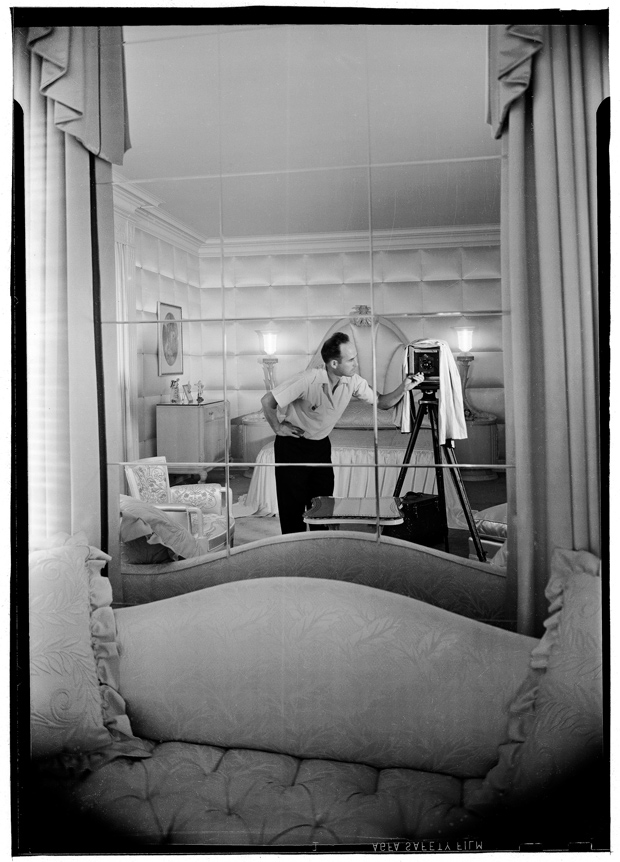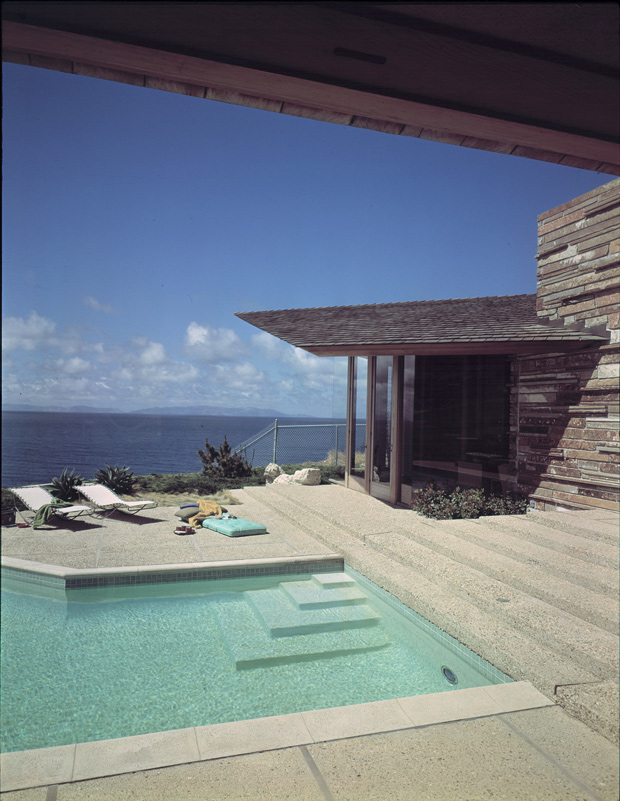The blog of The Huntington Library, Art Museum, and Botanical Gardens.
Maynard L. Parker’s American Dream
Posted on Thu., Nov. 15, 2012 by

Cover featuring M. Chaffin residence, Emerald Bay, Laguna Beach, California, 1948. Landscape architect: Fred Lang. Color transparency, 5 x 4 in. (12.7 x 10.2 cm).
“Maynard L. Parker (1900–1976) built a career making residential spaces look their alluring best,” says Jennifer A. Watts on the jacket copy of the new book that she edited about the acclaimed architectural photographer. Maynard L. Parker: Modern Photography and the American Dream is a sumptuous volume, replete with hundreds of photographs and rounded out by a group of essays from leading scholars who set the scene for Parker’s photographic oeuvre: a backdrop that included the Cold War (think bomb shelters), the development of modern conveniences, and the aspirations of suburbia (from convenient carports to automatic dishwashers).
Watts and the new book are featured in an interview in today’s New York Times. She’s also slated to be a guest on Larry Mantle’s AirTalk on KPCC on Thanksgiving Day, along with one of the contributors to the volume, architectural critic Christopher Hawthorne.
Watts' name might ring an instant bell: She’s the curator of one of our current Civil War exhibitions—“A Strange and Fearful Interest: Death, Mourning, and Memory in the American Civil War.” And while doing that with her right hand, she steered the production of this amazing book, based on The Huntington’s collection, acquired in 1995, of some 58,000 photographs, negatives, and other materials documenting the work of architects, interior designers, landscape architects, artists, builders, real estate developers, and clients associated with these fields.

Maynard L. Parker at work in the bedroom of the Hilda Boldt Weber residence, Bel Air, Los Angeles, 1939. Architect: James E. Dolena; interior designer: T. H. Robsjohn-Gibbings. Film negative, 7 × 5 in. (17.8 × 12.7 cm).
Parker focused much of his attention on the modern home and garden in mid-20th-century America. His work appeared in House Beautiful, Architectural Digest, Better Homes and Gardens, Sunset, and other popular home and design magazines of the times.
Jenny said she was inspired to assemble a book after she worked to put thousands of pictures from The Huntington’s collection of Parker’s photographs online.
“The material provides such a rich visual resource for anyone interested in this critical period for American architecture and the built environment,” she says. “But it’s also fascinating in the way it traces the cultural development of a casual style of living that took firm root first in California and exerted national, then international, influence.”
Based in Los Angeles, Parker traveled the country from the 1930s through the 1960s photographing the work of architects Frank Lloyd Wright, E. Fay Jones, Anshen and Allen, and A. Quincy Jones, among many others. His images feature the interior and furniture design of T. H. Robsjohn-Gibbings, Paul T. Frankl, Paul László, and Samuel Marx and the landscape architecture of such noted practitioners as Arthur and Marie Berger.
He was most prolific at home, however—on the West Coast, where he photographed the work of pioneering ranch house builder Cliff May, the Greene and Greene–influenced homes of modern architect Harwell Hamilton Harris, and the work of African American architect Paul Williams. He captured California’s outdoor lifestyle in sunwashed images of the patios, lush lawns, and backyard swimming pools of landscape architect Thomas Church and others.

Judge Anderson residence, Palos Verdes Estates, California, ca. 1963. Architect: Aaron G. Green, Color transparency, 7 × 5 in. (17.8 × 12.7 cm).
The Parker collection is also strong in images of celebrity homes that epitomized the era, including those of Judy Garland, Alfred Hitchcock, Bob Hope, and Bing Crosby.
Aside from Watts, contributors to the book include Edward R. Bosley, director of the Gamble House in Pasadena, Calif.; Daniel R. Gregory, former senior editor of Sunset magazine; Christopher Hawthorne, architecture critic for the Los Angeles Times; Elaine Tyler May, professor of American studies at the University of Minnesota; Monica Penick, assistant professor in design studies at the University of Wisconsin-Madison; Charles Phoenix, author and performer; D. J. Waldie, essayist and contributing editor for the Los Angeles Times; and Sam Watters, an architectural and cultural historian.
The book is available in The Huntington’s Bookstore & More, at major booksellers, and online. It’s published by Yale University Press in association with The Huntington Library, Art Collections, and Botanical Gardens.
You can access an audio slideshow about the collection narrated by Watts on The Huntington’s website. For more on this story, check out News Bytes in the spring/summer 2013 issue of Huntington Frontiers, downloadable in PDF form here.
Susan Turner-Lowe is the vice president for communications at The Huntington.